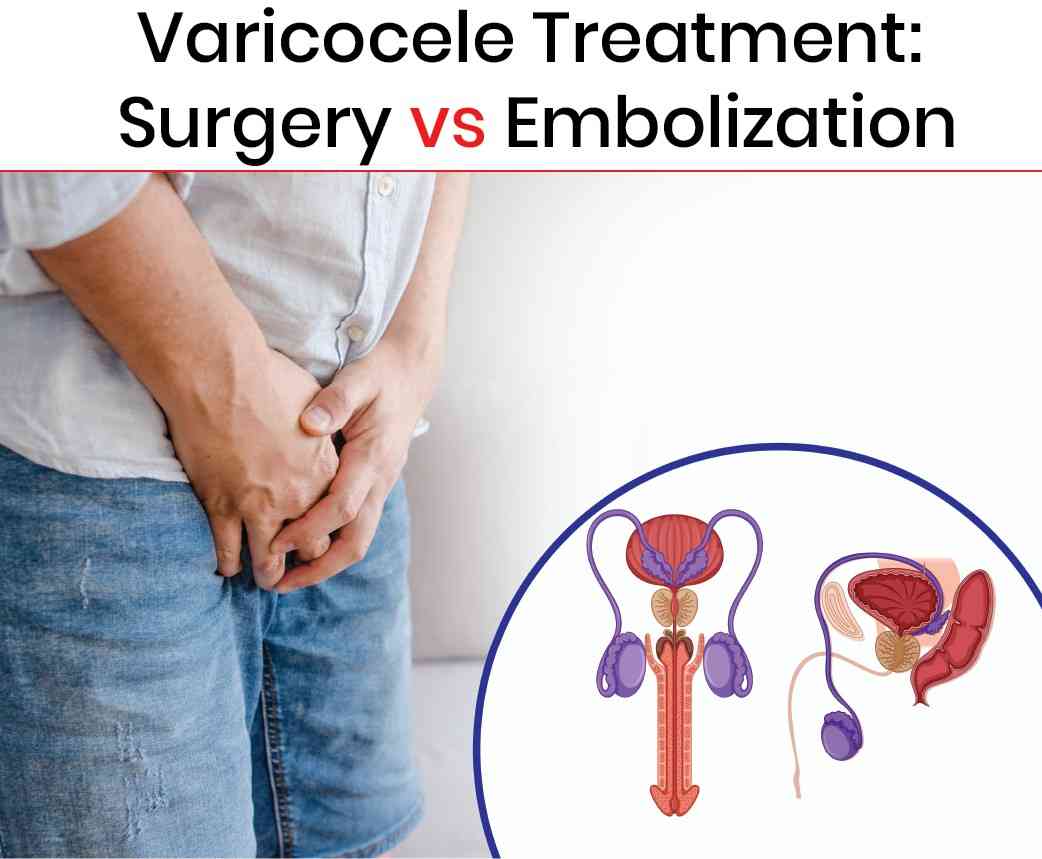Varicoceles, an enlargement of veins within the scrotum, can cause discomfort, pain, and even fertility issues. When it comes to treatment, two primary options are available: surgical repair (varicocelectomy) and embolization. Here, we explore each of the methods of treatment and compare their merits and demerits.
Treatment Methods Explained
Varicocele Surgery (Varicocelectomy)
- Open Surgery: The surgeon makes an incision in the groin or lower abdomen to access and tie off the enlarged veins, redirecting blood flow to normal veins.
- Laparoscopic Surgery: Several small incisions are made, and a laparoscope (a thin tube with a camera) is inserted. The surgeon uses instruments to clip or tie off the varicose veins.
- Microsurgical Varicocelectomy: Using a high-powered microscope, the surgeon makes a small incision in the groin and precisely ties off the affected veins, improving visualization and reducing complications.
Varicocele Embolization
Procedure:
A small incision is made, usually in the groin or neck.
A catheter is inserted and guided to the affected veins using X-ray imaging.
Coils or a sclerosing agent are released into the veins, blocking blood flow to the varicocele, causing the veins to shrink and scar down.
Point-by-Point Comparison
1. Treatment Method:
- Surgery: Involves physically tying off or removing veins through incisions (open, laparoscopic, or microsurgical).
- Embolization: A catheter-based approach using coils or sclerosing agents to block blood flow to the varicocele.
2. Benefits:
Surgery:
- High Success Rate: Effectively resolves varicoceles and alleviates symptoms.
- Long-term Results: Durable outcomes with low recurrence rates.
- Improved Fertility: Can enhance sperm quality and fertility potential.
Embolization:
- Minimally Invasive: Less pain and quicker recovery.
- Reduced Risk of Complications: Lower risk of infection and bleeding.
- No Visible Scarring: No significant scarring due to the small puncture.
3. Potential Complications:
Surgery:
- Surgical Risks: Includes bleeding, infection, and anesthesia complications.
- Postoperative Pain: Pain and discomfort are common post-surgery.
- Scarring: May result in small but visible scars.
Embolization:
- Allergic Reactions: Possible reaction to embolic materials.
- Thrombosis: Rare risk of blood clots in treated veins.
4. Cost of Treatment:
- Surgery: Costs vary based on the type of procedure, facility, surgeon fees, and insurance coverage. Generally, it can be costlier due to hospitalization and surgical team involvement.
- Embolization: May be more expensive initially due to the specialized nature of the procedure, but outpatient status and quicker recovery can offset various costs.
5. Recurrence Rates:
- Surgery: Low recurrence rates, but varicoceles can reappear if all affected veins aren’t completely addressed.
- Embolization: Generally low recurrence rates, though long-term data is more limited. Ensuring a skilled interventional radiologist minimizes this risk.
6. Recovery Time:
- Surgery: Recovery typically takes a few days to weeks. Patients need to avoid strenuous activities and follow postoperative care instructions closely.
- Embolization: Faster recovery, often within a few days. Patients can resume normal activities much sooner, with less postoperative discomfort.
Choosing the Right Treatment
Both varicocele surgery and embolization offer effective solutions, each with distinct advantages and potential downsides. The decision between the two should be made based on individual circumstances, health conditions, and personal preferences, in consultation with a healthcare provider. By comparing these treatments side by side, patients can better understand their options and make informed choices to achieve the best possible outcomes.




